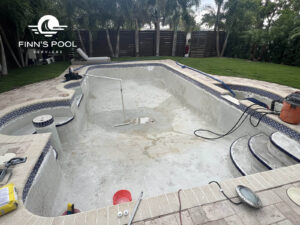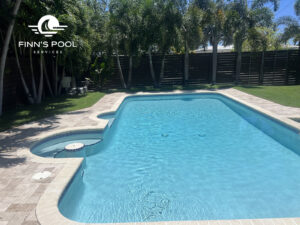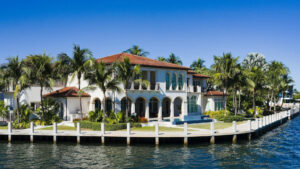A swimming pool is more than just a place to cool off — it’s a central part of your outdoor lifestyle. But over time, even the best-maintained pools begin to fade, crack, or develop rough spots. If you’re noticing cosmetic damage or structural wear, it may be time to explore pool resurfacing in West Palm Beach.
When it comes to finishes, the two most popular options are plaster and pebble. So which one is better? This guide compares pebble vs plaster pool resurfacing to help you make an informed choice that fits your lifestyle, budget, and pool usage.
Signs It’s Time to Resurface Your Pool
Even with consistent pool cleaning in West Palm Beach, all finishes eventually wear out. Common indicators include:
- Peeling or pitted plaster
- Discoloration that can’t be cleaned
- Rough patches that scrape feet
- Visible cracks or leaks
- Dull, lifeless appearance
If your pool is over 15 years old or you’ve had multiple acid washes, resurfacing isn’t just cosmetic — it’s essential to safety and function.
Key Differences for Pebble vs Plaster Pool Resurfacing
If you’re weighing pebble vs plaster pool resurfacing, here are the key differences:
Plaster Finish
Plaster is the classic pool finish — a mixture of cement and sand that creates a smooth, bright look.
- Smooth texture underfoot
- Bright, clean aesthetic
- Lower initial cost
- Typically lasts 7–10 years
- Prone to etching and stains if water chemistry fluctuates
Pebble Finish
Pebble finishes blend small river pebbles with cement for a more natural, durable surface.
- Textured, organic feel
- Highly durable (15–20 years+)
- Resists staining and chemical damage
- Available in a wide range of colors and aggregate blends
- Higher upfront cost but lower long-term maintenance
Water Chemistry and Finish Longevity
South Florida pools face tough conditions — sun, heat, humidity, and frequent use. And if your water chemistry is off (even slightly!), it can seriously impact how long your pool finish lasts. Taking this into consideration for pebble vs plaster pool resurfacing, it’s important to note that:
- Plaster is more vulnerable to poor chemical balance. Even short-term imbalance can cause scaling, etching, or discoloration.
- Pebble surfaces are far more resistant to water chemistry issues, making them ideal for saltwater systems or homes with inconsistent pool care routines.
If your pool requires frequent balancing or you’ve struggled with algae or scale buildup, pebble is the safer bet for long-term durability.
User Experience: Look & Feel
The way a finish looks and feels matters — after all, you’re in this pool to enjoy it.
- Plaster offers a classic, clean appearance and a silky texture. It can be slick underfoot, especially in shallow areas, which some swimmers love and others find too slippery.
- Pebble adds texture and depth, creating a natural, lagoon-like look. The surface has slight texture — not rough, but not glassy smooth either. It’s popular with homeowners going for a tropical or high-end design.
Underwater lighting makes both surfaces look stunning, but pebble’s natural variation often adds more visual interest at night.
Environmental Considerations in West Palm Beach
Florida weather is no joke. Pools here endure:
- Intense UV exposure that fades finishes over time
- Saltwater systems, which can wear down traditional plaster
- Frequent storms and heavy rain, which affect pH balance and introduce contaminants
Because of these challenges, professional pool builders in West Palm Beach often recommend pebble finishes. They’re built to handle high exposure environments and require less aggressive maintenance to stay looking sharp.
Warranty Differences
Always ask about warranties when planning resurfacing. In general:
- Plaster finishes often come with 1–5 year warranties (depending on the contractor and mix used).
- Pebble finishes frequently carry 10–15 year warranties, with many manufacturers backing them due to their proven durability.
A longer warranty doesn’t just protect your investment — it signals that the product is built to last.
Comparison Chart: Pebble vs Plaster Pool Resurfacing
Choosing the right finish for your pool resurfacing project depends on your priorities. This pebble vs plaster pool resurfacing comparison highlights the key features.
| FEATURE | PLASTER | PEBBLE |
| Appearance | Smooth, uniform | Natural, textured |
| Texture | Silky smooth | Slightly textured |
| Lifespan | 7–10 years | 15–20+ years |
| Water Chemistry Tolerance | Low | High |
| Stain Resistance | Moderate | Excellent |
| Warranty (Typical) | 1–5 years | 10–15 years |
| Cost (Relative) | Lower | Higher |
| Aesthetic Variety | Limited | High |
Before & After: Pool Resurfacing Results
This type of visual is excellent for demonstrating the difference a new surface can make. Want help deciding which finish is right for your pool’s shape, age, or design? Just ask.
Frequently Asked Questions
How long does pebble vs plaster pool resurfacing take?
The type of finish doesn’t drastically change the timeline. Most pebble or plaster pool resurfacing projects take about 7–14 days, depending on the pool’s size, weather conditions, and prep work required.
Does pebble feel rough on bare feet?
Modern pebble finishes are polished smooth. You’ll feel slight texture, but not discomfort.
How much does pebble vs plaster pool resurfacing cost?
Plaster is generally the more affordable option, while pebble finishes cost more upfront due to materials and installation. On average, plaster resurfacing ranges from $5,000–$8,000, while pebble finishes can run $7,000–$12,000+. However, pebble may offer better long-term value thanks to its durability.
Can I switch from plaster to pebble during resurfacing?
Yes — switching finishes is common and often improves durability and aesthetic appeal.
Which lasts longer—pebble or plaster resurfacing?
Pebble finishes typically last 15–20+ years, while plaster surfaces last around 7–10 years. If longevity is your top priority, pebble is the better investment. However, both can perform well with proper water chemistry and routine maintenance.
Will resurfacing fix leaks?
Minor surface leaks can be repaired during resurfacing, but deeper structural leaks may require additional repair.
Thinking About Other Pool Finish Options?
If you’re still comparing finishes, you might also want to read our related guide:
Quartz vs. Pebble Pool Finish: Which Is Best for You?
It explores a third finish option that blends durability and sparkle — great for homeowners wanting a more modern, high-end look.
Contact Finn's Pool Services for Expert Pool Resurfacing in West Palm Beach, FL
Still unsure whether pebble or plaster is the right call? We’ll help you choose a finish that fits your pool, your lifestyle, and your long-term maintenance goals.
Contact Finn’s Pool Services for expert pool resurfacing in West Palm Beach, including inspections, crack repair, resurfacing prep, and custom finishes. We’ll get your pool looking — and feeling — like new.
- Phone: 561-702-6351
- Email: [email protected]
-
Address: 1109 Old Okeechobee Rd. #2
West Palm Beach, FL 33401 - Mon – Fri: 8:00 AM – 6:00 PM
- Sat & Sun: 9:30 AM – 4:00 PM





